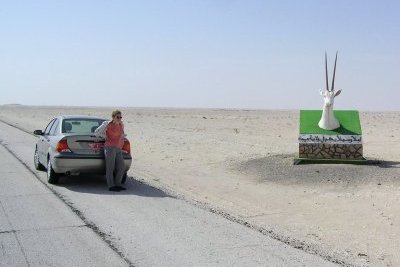Oman
Arabian Oryx Sanctuary
Site Info
Official Information
- Full Name
- Arabian Oryx Sanctuary (ID: 654)
- Country
- Oman
- Status
-
Delisted 2007
Site history
History of Arabian Oryx Sanctuary
- 2007: Removed from WH List
- Wild population of Arabian Oryx in decline, reduction of the size of the Sanctuary and no protective measures have been carried out
- 1993: Deferred
- Jiddat-al-Harasis: Bureau - concern about protection, oil exploration etc.
- Type
- Natural
- Criteria
- x
Links
- UNESCO
- whc.unesco.org
- Related
-
- de.wikipedia.org — Link
- rekel.nl — Link
- perso.wanadoo.fr — Link
All Links
UNESCO.org
- whc.unesco.org — whc.unesco.org/
Related Resources
- de.wikipedia.org — Link
- rekel.nl — Link
- perso.wanadoo.fr — Link
News Article
- Oct. 1, 2012 yomiuri.co.jp — Mt. Fuji, Kamakura cultural listing seen slim
- Aug. 12, 2008 washingtonpost.com — The story behind the Arabian Oryx delisting
- July 1, 2007 reuters.com — UNESCO removes Oman oryx sanctuary from heritage list
Community Information
- Community Category
- Wildlife habitat: Fauna
Travel Information
Recent Connections
News
- yomiuri.co.jp 10/01/2012
- Mt. Fuji, Kamakura cultural listin…
- washingtonpost.com 08/12/2008
- The story behind the Arabian Oryx …
- reuters.com 07/01/2007
- UNESCO removes Oman oryx sanctuary…
Recent Visitors
Visitors of Arabian Oryx Sanctuary
Community Reviews
Show full reviewsOur visit to the Oryx sanctuary was simply unforgetable. The government of Oman at the instruction of the Sultan has set aside vast tracts of land (hundreds of square miles) to preserve the habitat for and to try and re introduce into the wild these rare animals following a scheme of protective breeding. We are fortunate to live in Oman and were able to get the correct permits faxed to us to give permission to visit and camp at the site (we were the only visitors). Whist there, we were treated to dawn and dusk patrols out with the rangers in the back of their pick ups. At night we camped in a most fabulous deserted spot, surrounded by Arabian Gazelle. Truly a lovely experience.
Keep reading 0 comments
Making a proper visit to this WHS is not a practical possibility for the ordinary “passing tourist”
The Birdwatching Guide to Oman (H+J Eriksen) provides excellent detailed maps for all the best birding sites in Oman but, it says of the Oryx Sanctuary :-
“Jaaluni is the field station of the Arabian Oryx Project located on the flat desert plain of the Jiddat al Harasis. The area is east of the Muscat – Salalah road and north of the Hayma – Al Duqm road. No map is provided as visitors should not attempt to find the area on their own and all access is via mere desert tracks. Birdwatchers wanting to visit must seek prior permission from the project head office in Muscat. …. If the visit is granted, the staff from the field station will pick up the visitors in Hayma or other agreed location and lead the way to Jaaluni, Tour operators in the capital area such as Siw Rantapaa-Buring or Heide Beal may also secure a permit. For resident birdwatchers the easiest way to visit may be to join the Historical Association of Oman on one of their yearly or twice yearly visits”
The boundaries of the site do however cross the main Muscat - Salalah road north of Hayma (see the Advisory Body report on the UNESCO Web site) So if you make that journey you will, in strict terms, have “visited” the WHS!!
The park continues south east all the way …
Keep reading 0 comments